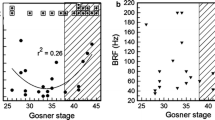Abstract
The cephalopod receptor of particle motion was identified. In a previous study, it was suggested that statocysts served this function, but there was no direct supporting evidence, and epidermal hair cells had not been conclusively ruled out. Experiments on Octopus ocellatus were conducted using respiratory activity as an indicator of sound perception. Intact animals clearly responded to 141-Hz particle motion at particle accelerations below 1.3×10−3 m/s2, and the mean perception threshold at this frequency was approximately 6.0×10−4 m/s2. Specimens in which the statoliths had been surgically removed did not show any response for accelerations up to 3.9×10−3 m/s2 at 141 Hz, which was approximately 16 dB greater than the mean perception threshold at this frequency. Specimens that had undergone a control operation in which the statoliths remained intact showed positive responses at 2.8×10−3 m/s2 for the same frequency stimulus. This indicates that the statocyst, which is morphologically similar to the inner ear system in fish, is responsible for the observed responses to particle motion in O. ocellatus. This is the first direct evidence that cephalopods detect kinetic sound components using statocysts.
Similar content being viewed by others
References
Sand O. The lateral line and sound reception. In: Tavolga WN, Popper AN, Fay RR (eds). Hearing and Sound Communication in Fishes. Springer-Verlag, New York, NY. 1981; 459–480.
Rogers PH, Cox M. Underwater sound as a biological stimulus. In: Atema J, Fay RR, Popper AN, Tavolga WN (eds). Sensory Biology of Aquatic Animals. Springer-Verlag, New York, NY. 1988; 131–149.
Coombs S, Janssen J, Montgomery J. Functional and evolutionary implications of peripheral diversity in lateral line systems. In: Webster DB, Fay RR, Popper AN (eds). The Evolutionary Biology of Hearing, Springer-Verlag, New York, NY. 1992; 267–294.
Karlsen HE. The inner ear is responsible for detection of infrasound in the perch (Perca fluviatilis). J. Exp. Biol. 1992; 171: 163–172.
Sand O, Karlsen HE. Detection of infrasound by the Atlantic cod. J. Exp. Biol., 1986; 125: 197–204.
Kalmijn AJ. Hydrodynamic and acoustic field detection. In: Atema J, Fay RR, Popper AN, Tavolga WN (eds). Sensory Biology of Aquatic Animals. Springer-Verlag, New York, NY. 1988; 83–130.
Popper AN, Rogers PH, Saidel WM, Cox M. Role of the fish ear in sound processing. In: Atema J, Fay RR, Popper AN, Tavolga WN (eds). Sensory Biology of Aquatic Animals. Springer-Verlag, New York, NY. 1988; 687–710.
Young JZ. The statocysts of Octopus vulgaris. Proc. R. Soc. Lond. B 1960; 152: 3–29.
Budelmann BU, Bleckmann H. A lateral line analogue in cephalopods: water waves generate microphonic potentials in the epidermal head lines of Sepia and Lolliguncula. J. Comp. Physiol. A 1988; 164: 1–5.
Maturana HR, Sperling S. Unidirectional response to angular acceleration recorded from the middle cristal nerve in the statocyst of Octopus vulgaris. Nature 1963; 197: 815–816.
Budelmann BU, Williamson R. Directional sensitivity of hair cell afferents in the Octopus statocyst. J. Exp. Biol. 1994; 187: 245–259.
Williamson R. Vibration sensitivity in the statocyst of the northern octopus, Eledone cirrosa. J. Exp. Biol. 1988; 134: 451–454.
Williamson R, Budelmann BU. The response of the Octopus angular acceleration receptor system to sinusoidal stimulation. J. Comp. Physiol. A 1985; 156: 403–412.
Packard A, Karlsen HE, Sand O. Low-frequency hearing in cephalopods. J. Comp. Physiol. A 1990; 166: 501–505.
Kaifu K, Segawa S, Tsuchiya K. Behavioral responses to underwater sound in the small benthic octopus Octopus ocellatus. J. Mar. Acoust. Soc. Jpn 2007; 34: 266–273.
Packard A, Trueman ER. Muscular activity of the mantle of Sepia and Loligo (Cephalopoda) during respiratory movements and jetting, and its physiological interpretation. J. Exp. Biol. 1974; 61: 411–419.
Lovell JM, Findlay MM, Moate RM, Yan HY. The hearing abilities of the prawn Palaemon serratus. Comp. Biochem. Physiol. A 2005; 140: 89–100.
Budelmann BU. Hearing in nonarthropod invertebrates. In: Webster DB, Fay RR, Popper AN (eds). The Evolutionary Biology of Hearing. Springer-Verlag, New York, NY. 1992; 141–155.
Anken RH, Rahmann H. Gravitational zoology: how animals use and cope with gravity. In: Horneck G, Baumstark-Khan C (eds). Astrobiology: The Quest for the Conditions of Life. Springer, Berlin. 2002; 314–332.
de Vries HI. Physical aspects of the sense organs. In: Butler JAV (ed.). Progress in Biophysics and Biophysical Chemistry. Pergamon Press, London. 1956; 208–264.
Maniwa Y. Attraction of bony fish, squid and crab by sound. In: Schuijf A, Hawkins AD (eds). Sound Reception in Fish. Elsevier, Amsterdam. 1976; 271–283.
Hanlon RT, Budelmann BU. Why cephalopods are probably not ‘deaf’. Am. Nat. 1987; 129: 312–317.
Karlsen HE. Infrasound sensitivity in the plaice (Pleuronectes platessa). J. Exp. Biol. 1992; 171: 173–187.
Sand O, Karlsen HE. Detection of infrasound and linear acceleration in fishes. Philos. Trans. R. Soc. Lond. B 2000; 355: 1295–1298.
Author information
Authors and Affiliations
Corresponding author
Rights and permissions
About this article
Cite this article
Kaifu, K., Akamatsu, T. & Segawa, S. Underwater sound detection by cephalopod statocyst. Fish Sci 74, 781–786 (2008). https://doi.org/10.1111/j.1444-2906.2008.01589.x
Received:
Accepted:
Issue Date:
DOI: https://doi.org/10.1111/j.1444-2906.2008.01589.x




